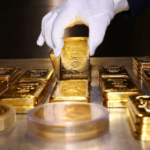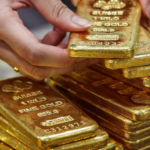Gold has captivated human civilizations for millennia, serving as a symbol of wealth, power, and security. Its enduring value is reflected in its continuous demand, making it one of the most significant commodities in global finance. Today, gold remains central to the world’s economic landscape, not only as an investment asset but also as a safe haven during periods of financial instability. This article explores the current state of the global gold market, examining the key trends, challenges, and opportunities in 2024.
1. The Global Gold Market Overview
The global gold market is a multi-faceted ecosystem that encompasses physical gold trading, gold futures, mining, refining, and investment. According to the World Gold Council, annual global gold demand typically hovers around 4,000 tons, driven by a mix of consumer demand (jewelry, technology) and investment demand (bullion, coins, exchange-traded funds).
Gold is primarily traded in major financial hubs like London, New York, Zurich, Shanghai, and Hong Kong, where it can be bought and sold through various channels, including physical gold markets, futures contracts, and derivatives. Gold prices are set twice daily in London via the London Bullion Market Association (LBMA) auction process, which serves as the benchmark for global gold pricing.
2. Key Factors Influencing Gold Prices Today
Several factors play pivotal roles in shaping the price of gold:
- Inflation and Interest Rates: Gold is highly sensitive to inflation and interest rate changes. As a non-yielding asset, its opportunity cost increases when interest rates rise. However, during periods of high inflation, gold is sought after as a hedge against currency devaluation. In 2023-2024, central banks worldwide have been grappling with persistent inflation, leading to periodic increases in interest rates, which have led to fluctuations in gold prices.
- Geopolitical Uncertainty: Gold thrives on uncertainty. During periods of geopolitical tension or financial crises, investors seek gold as a safe-haven asset. In recent years, global events such as the Russia-Ukraine conflict, trade tensions between major economies like the U.S. and China, and rising concerns about global debt have kept gold in focus as a refuge for investors.
- Currency Movements: The U.S. dollar and gold have an inverse relationship. When the dollar strengthens, gold prices often fall, and vice versa. In 2024, the dollar has remained strong due to robust U.S. economic data, placing some pressure on gold prices. However, any future weakening of the dollar due to policy shifts or economic downturns could drive gold prices higher.
- Central Bank Purchases: Central banks are significant players in the global gold market. In 2023, central banks globally purchased a record 1,136 tons of gold, a continuation of a long-standing trend. Countries like China, India, and Russia have significantly increased their gold reserves to reduce their reliance on the U.S. dollar. This trend has bolstered gold prices and reinforced the metal’s role in global financial stability.
3. Gold Production and Supply Chain Challenges
Gold mining continues to play a crucial role in the overall supply of gold. In 2023, global mine production was approximately 3,600 tons. The top gold-producing countries are China, Russia, Australia, and the United States, which together account for nearly half of global gold production.
However, gold mining faces numerous challenges today:
- Environmental Concerns: The environmental impact of gold mining has garnered increased scrutiny. Extracting gold is a resource-intensive process that requires large amounts of energy and water, and it often results in deforestation and land degradation. Additionally, gold mining can produce harmful waste by-products such as cyanide and mercury. To address these concerns, there has been a growing emphasis on responsible mining practices, particularly in developed countries, with stricter regulations governing environmental standards.
- Depleting Reserves: While gold reserves are finite, the rate of discovery of new gold deposits has slowed in recent years. Many of the world’s major gold mines have been in operation for decades, and their output is gradually declining. This has pushed miners to explore more challenging and expensive regions, such as deep-sea mining or remote areas of Africa, Latin America, and Asia.
- Political and Regulatory Risks: Mining operations are often subject to political instability and regulatory changes, particularly in developing nations. Governments may impose higher taxes, stricter environmental standards, or even nationalize resources, creating uncertainty for mining companies.
4. Investment Trends: Gold Bullion, ETFs, and Digital Gold
Gold remains an attractive investment option, offering stability and protection against market volatility. Today, investors have several options to gain exposure to gold, each with its benefits and risks.
- Physical Gold: Owning physical gold in the form of bullion bars or coins remains a popular method of investment. Investors value the tangibility of physical gold and its inherent value, which can be stored and passed down through generations. However, owning physical gold comes with costs, such as storage and insurance, and selling gold can involve premiums or fees.
- Gold ETFs: Gold exchange-traded funds (ETFs) offer a convenient way to invest in gold without the need for physical storage. ETFs are backed by physical gold and track its price movements. Investors can buy and sell ETFs just like stocks, making them highly liquid. In 2024, gold ETFs remain a popular investment vehicle, especially for institutional investors who prefer exposure to gold without the associated costs of physical ownership.
- Digital Gold: The advent of digital currencies and blockchain technology has introduced digital gold platforms, allowing investors to buy fractional shares of gold online. These platforms, like Vaulted or Glint, give investors the flexibility to buy, sell, and store gold electronically. Digital gold offers low entry costs and convenience, but it may carry counterparty risk if the platform fails or is hacked.
5. Future Outlook for Gold in 2024 and Beyond
As we look toward the future, several trends and developments are likely to shape the gold market in 2024 and beyond:
- Sustainability in Mining: With increased focus on environmental, social, and governance (ESG) issues, the gold mining industry will need to adopt greener technologies and sustainable practices. Companies that can meet ESG standards may see increased investment, while those that fail to adapt could face higher regulatory risks and reputational damage.
- Technological Advancements: The gold industry is embracing technological innovations such as AI and automation to enhance mining efficiency and exploration. Advancements in recycling technology could also play a significant role in increasing gold supply by recovering gold from electronic waste, reducing the need for new mining.
- Central Bank Policies: As central banks continue to manage inflationary pressures, their monetary policies will play a critical role in shaping the future demand for gold. If inflation persists or geopolitical tensions escalate, gold could see further price appreciation as investors seek stability.
Conclusion
Gold remains a pillar of global finance, offering security in times of uncertainty and volatility. As 2024 unfolds, the global gold market will continue to be shaped by macroeconomic factors, environmental concerns, and evolving investor preferences. Whether through physical bullion, ETFs, or digital gold platforms, gold remains a crucial asset for investors seeking diversification and protection against economic instability.






